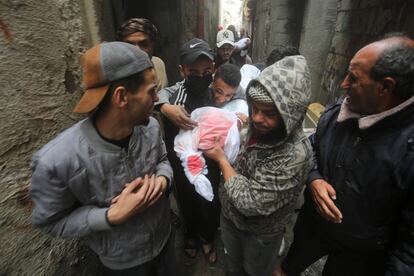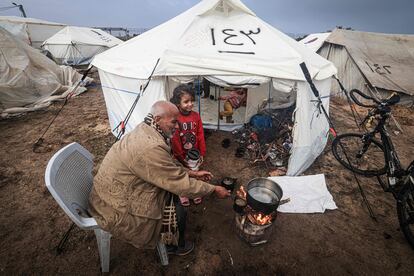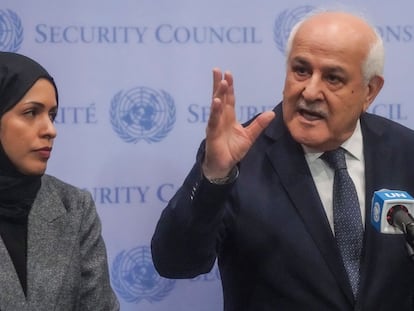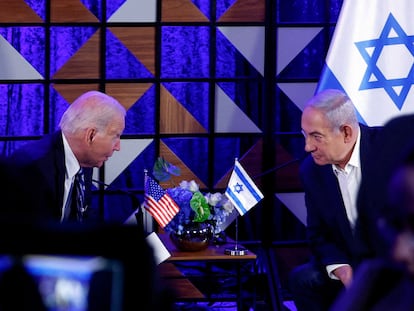Following the UN vote and Biden’s criticism, Israel says that it will continue the war in Gaza ‘with or without international support’
Hamas has continued to resist and killed nine Israeli soldiers in an ambush in the same northern neighborhood where it put troops at risk in 2014

Israel’s military and diplomatic fronts have become more complicated recently. The nine Israeli soldiers killed in Tuesday’s ambush in the Gaza neighborhood of Shujaiya demonstrate that, in the war’s third month, the Palestinian armed resistance continues to seriously battle the occupation troops. A colonel was among the victims; he is the highest-ranking military officer to lose his life in the ground incursion, with intense battles in both the northern and southern parts of the Gaza Strip. The ambush on Tuesday made it the worst day the Israeli army has experienced in the Palestinian enclave during the present conflict. Moreover, the attack came as Israel is openly at odds with its main ally, the United States, and losing international support, after the United Nations General Assembly passed a resolution calling for a ceasefire, albeit in a non-binding vote.
Nevertheless, “Israel will continue the war against Hamas with or without international support,” Foreign Minister Eli Cohen said on Wednesday. Shortly before, he had commented that the country “is heartbroken” by the casualties it suffered a few hours earlier in Gaza, acknowledging that it has lost some of its “best” men. Cohen added that “at the present juncture, a ceasefire would be a gift to the Hamas terrorist organization and would allow them to return and threaten the inhabitants of Israel once again.” With that, he doubled down on a strategy that is increasingly being called into question. The burden of over 18,500 deaths caused by the attacks in the Gaza Strip and the growing humanitarian crisis affecting 1.8 million internally displaced persons is growing.
Recent rainfall has left images of makeshift camps in the mud, further complicating the survival of a population that has fled their homes because of the bombings and does not have the necessary supplies to face the winter weather. Meanwhile, American media such as The Wall Street Journal report that Israel has already begun the operation to flood with seawater the system of the tunnels that Hamas is using to defend itself, as well as to hide over 130 hostages still being held in its custody. The effort could take weeks.
Tuesday’s ambush took place in the heart of Shujaiya, a densely populated area, where soldiers were attacked from buildings and, according to the Israeli press account, a bomb is suspected to have been detonated from there. The soldiers responded with their weapons as they split into groups, but when a rescue team arrived on the scene to assist them, a second explosion occurred. Two of the dead are Colonel Itzhak Ben Basat, 44, and Lieutenant Colonel Tomer Greenberg, 35, both commanders of the Golani Brigade, an elite corps that lost other soldiers in the same clash. Ben Basat is the highest-ranking Israeli military officer to die during the ground operation that began on October 27 and in which 115 soldiers have already lost their lives.
For days, the neighborhood of Shujaiya, located in the east of Gaza City overlooking the border with Israel, has been the scene of intense clashes. With a network of alleys often inaccessible to tanks, bulldozers and armored vehicles, this is the place where Israel stumbled in 2014, during the last battle fought in the Gaza Strip. Shortly before the ambush, Defense Minister Yoav Gallant had remarked to a group of military personnel that “Gaza City is gradually crumbling and soon we will destroy the entire Hamas infrastructure.” The day before, the minister had even remarked that “Hamas is on the verge of collapse.” The political and diplomatic battlefield, where the heads of government of Israel and the United States are confronting each other, runs parallel to the military scenario inside the Gaza Strip, where the army maintains its determination to wipe out the Islamist militia.
“The Shujaiya incident was to be expected,” says Guillermo Pulido, a defense analyst with Ejércitos [Armies] magazine. He does not believe that Israel is doing badly in Gaza. That neighborhood has been “one of Hamas’s strongholds for many years. Moreover, the layout of the neighborhood is quite problematic for offensive urban warfare and favors defensive [activities],” he adds, mentioning the battle on July 20, 2014, between the same actors. On that day, Israel bombed part of the neighborhood from the air and killed dozens of civilians to save members of the Golani Brigade, who fell victim to a Hamas ambush.
The U.N. resolution seeking a humanitarian ceasefire passed with 153 votes in favor, compared to 10 against and 23 abstentions. In addition to Israel and the United States, two European countries (Austria and the Czech Republic) rejected the resolution, joined by others from Latin America and Oceania and one African country (Liberia).
Known territory for the Islamist militia
Generally, military tactics hold that the attacker must fight with three times as many soldiers as the defending side. The Israeli troops are better equipped and armed and belong to a high-tech army, but the network of streets of the Shujaiya neighborhood, where almost 100,000 people used to live in 6 square kilometers (2.31 square miles), and the Jabaliya refugee camp are well known territory for militants, who have been waiting for the Israeli military for days or weeks for the chance to engage in a deadly ambush like the one on Tuesday. In addition, Israel faces another obstacle in Gaza: the glorification of martyrdom around the activities of Hamas members, and other Palestinian Islamist armed groups, which means that they do not see falling in battle as a loss.

Despite Israel’s unpopularity because of thousands of civilian casualties, Pulido believes that aviation has played an important role in countering the ability of Hamas and Islamic Jihad to attack Israeli territory with rockets. He observes that, crucially, the army destroyed many launching pads after the intense missile activity that took place in the first hours of the October 7 attack. “My opinion is that most of these rockets have already been destroyed by aerial bombardment,” the expert notes. According to information made public by the army, during the first hours of that day alone, the Islamist militia launched some 3,000 rockets from the Gaza Strip into Israeli territory.
Pulido does not believe that the militants have caused serious damage to tanks or other vehicles inside the Gaza Strip, many of which are equipped with the Trophy active protection system, which hinders the impact of the rocket launchers (RPG); the militants usually employ RPG to attack the Israeli soldiers, as shown in most of the videos recorded by Hamas. These recordings show very few fighters, who are almost always carrying out urban guerrilla tactics, the analyst adds. He believes that the ranks of the Islamists, “who rarely operate in platoons anymore,” have suffered serious damage in terms of both their men and their weapons and infrastructure.
As for the number of deaths in proportion to the number of attacks, the military analyst believes that “it is very low in Gaza,” considering the 20,000 attacked targets that Israel reported two days ago. The military analyst explains that “if there are 18,000 dead, there is less than one death per attack, in which more than one bomb or missile may have been used. In other contemporary battles, such as Mosul or Raqa, far more people died per attack. In Mosul, an estimated 10,000 civilians were killed and there were far fewer airstrikes.”
“Things are not going that badly for Israel, although it is not hammering [Hamas] as fast as it was believed [they would],” Pulido says. He has no doubt that, sooner or later, Hamas will lose the ability to stand up to the occupation troops, and then its men will have to “blend in with the population” and “go underground” to commit attacks to try and maintain a certain presence against the enemy. At that stage, Pulido anticipates, Israel will have to work more at the intelligence level, with “arrests, extortion and torture” to obtain information; according to Pulido, the Israelis have ample experience in such tasks. But with very active battle fronts in both the north and the south, that phase does not seem to be coming soon.
Sign up for our weekly newsletter to get more English-language news coverage from EL PAÍS USA Edition
Tu suscripción se está usando en otro dispositivo
¿Quieres añadir otro usuario a tu suscripción?
Si continúas leyendo en este dispositivo, no se podrá leer en el otro.
FlechaTu suscripción se está usando en otro dispositivo y solo puedes acceder a EL PAÍS desde un dispositivo a la vez.
Si quieres compartir tu cuenta, cambia tu suscripción a la modalidad Premium, así podrás añadir otro usuario. Cada uno accederá con su propia cuenta de email, lo que os permitirá personalizar vuestra experiencia en EL PAÍS.
¿Tienes una suscripción de empresa? Accede aquí para contratar más cuentas.
En el caso de no saber quién está usando tu cuenta, te recomendamos cambiar tu contraseña aquí.
Si decides continuar compartiendo tu cuenta, este mensaje se mostrará en tu dispositivo y en el de la otra persona que está usando tu cuenta de forma indefinida, afectando a tu experiencia de lectura. Puedes consultar aquí los términos y condiciones de la suscripción digital.
More information
Archived In
Últimas noticias
Most viewed
- Sinaloa Cartel war is taking its toll on Los Chapitos
- Oona Chaplin: ‘I told James Cameron that I was living in a treehouse and starting a permaculture project with a friend’
- Reinhard Genzel, Nobel laureate in physics: ‘One-minute videos will never give you the truth’
- Why the price of coffee has skyrocketed: from Brazilian plantations to specialty coffee houses
- Silver prices are going crazy: This is what’s fueling the rally











































